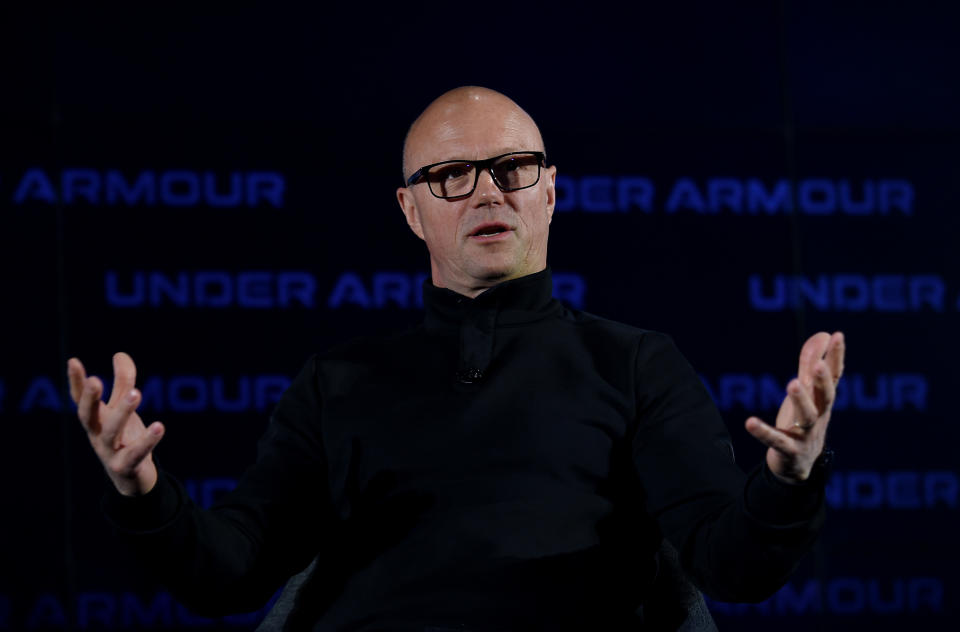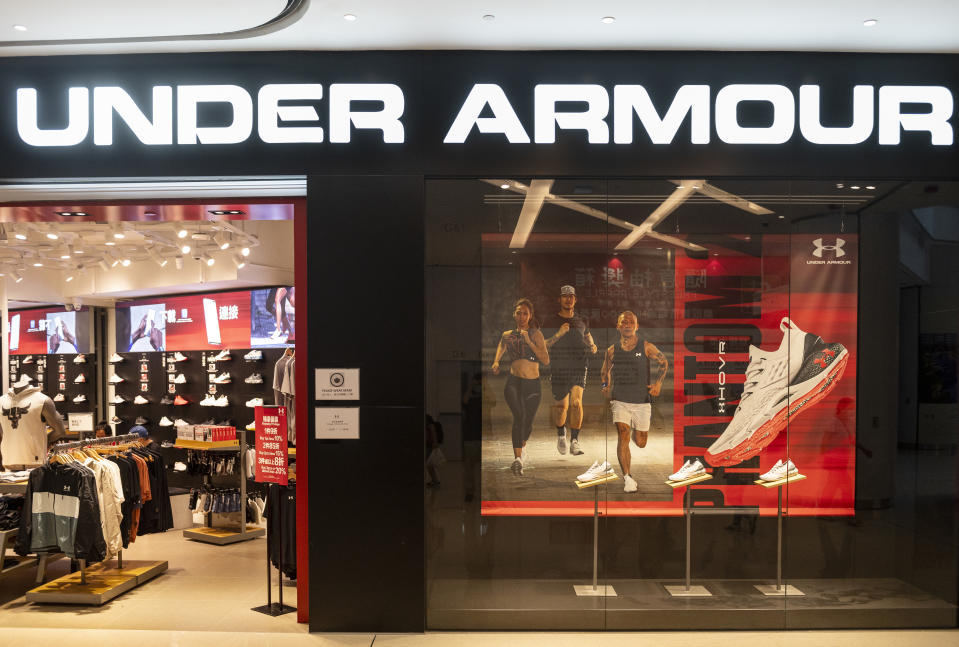Under Armour CEO: 'Everybody will be shrinking somewhat coming out of COVID'
For more than six years, Under Armour kept an incredible streak going for a publicly traded company: 26 straight quarters of at least 20% revenue growth. But when the streak ended in Q4 2016, it ended violently.
Since then, Under Armour (UA) has struggled in North America. Its U.S. sales have declined for seven straight quarters, giving up much of the apparel market share Under Armour had stolen from Nike (NKE) and Adidas (ADDYY). Bankruptcies of brick-and-mortar sporting goods stores didn’t help, but Under Armour also ignored the athleisure wave that Nike and Adidas happily rode.
Amid the slide, Under Armour executives have repeatedly said that Under Armour needs to become a “premium brand” again. Founder and then-CEO Kevin Plank said it in January 2017: “The role both we and our retailers expect us to play is as a premium, full-price brand... Our partners expect UA to be the premium brand of choice at their stores.”
Four years later, Under Armour’s new CEO Patrik Frisk is still saying it. “At the very core of it, what we’re trying to do is really reposition Under Armour as a premium brand,” Frisk told Yahoo Finance last week. “That’s where we want to play, that’s where we’re going to play going forward. We’re going to be in athletic performance, we’re going to be one of the big brands in the world globally, and we’re going to do that in a more premium way going forward.”
What being a “premium brand” really means: not discounting (or “price promoting,” in industry terms), and not flooding retail chains with product. Under Armour wants consumers to see its brand in the way they see Lululemon—but that’s going to be extremely difficult.
Many analysts think the path to becoming a premium brand again lies in “shrinking to grow”: intentionally shrinking sales volume in favor of profit margins. Under Armour would become a smaller (by revenue) but more profitable company. And analysts already see some potential signs Under Armour is doing that, like backing out of two massively expensive university sponsorships (UCLA and UC Berkeley) and backing out of its plan to open a huge Manhattan flagship retail store on Fifth Avenue.
But Patrik Frisk isn’t quite ready to say that’s the game plan.

When asked if Under Armour should shrink to grow, Frisk says, “I think everybody will be shrinking somewhat, right, coming out of COVID. And for us—as we have done all of the work, we feel, to really understand where we will compete, who we’re for, and who we are as a brand going forward—we are just making decisions of what that means to us in terms of distribution.”
As for whether Under Armour will exit more of its school sponsorships, Frisk says, “We’re committed to being a team sports brand. We have a relationship with over 1,000 schools right now in the U.S., so we’re definitely not exiting that. What we’re doing though is just making sure that where we’re engaging, we’re able to activate against it... We need to do that with fewer partners at this point in time, simply because of the resources that we have and where we feel we’re at right now as a brand.”
Frisk also brought up the difficulty of shrinking inventory quickly.
“When you grow at the speed that Under Armour was growing at over a very long period, 26 quarters, you get to a point where you actually do have to take a pause and reengineer and rejig yourself,” he says. “The reason it takes longer than people would like is the fact that in our world of making stuff—we make about 840,000 to 900,000 things a day—it takes time, because of calendar, because of supply chain, to make change happen as quickly as you would like... What you’ve seen in 2020 is Under Armour coming out leaner, meaner, and more coordinated than ever before because we’ve now done the hard work. We will compete as a smaller company, yes, we will be a little smaller, because we’ve had to go through COVID where we had to take almost a quarter of revenue right out of the year.”

All of that almost sounds like he’s saying Under Armour will shrink its distribution to focus on profit.
But by saying that “everybody” will shrink due to the pandemic, Frisk deemphasizes the concept. If some of Under Armour’s peers shrink due to the pandemic, Under Armour needs to shrink more.
Moreover, Nike is not really shrinking coming out of the pandemic: in its Q1 2021 earnings on Tuesday the company showed its sales are almost back to pre-pandemic levels. Amazon certainly isn’t going to shrink coming out of the pandemic.
“The question is, at the end of the day,” says BMO Capital Markets retail analyst Simeon Siegel, “when they put out less inventory and Nike is gaining share, will Frisk say, ‘That's good, we need to be smaller,’ or will he say, ‘Nike is stealing share, we need to price promote.’ They need to hold their ground, shrink volume, let Nike take share. Not give in and start cutting prices. They need to say, ‘Let’s do $4 billion in sales,’ and walk away from the $1 billion in sales that requires them to discount.”
Over the next year, Under Armour shareholders and analysts will closely watch what Under Armour does more than what it says.
—
Daniel Roberts is an editor-at-large at Yahoo Finance and covers sports business. Follow him on Twitter at @readDanwrite.
Read more:
3 signs Under Armour is ‘shrinking to grow’
Why Dick's Sporting Goods is wildly outperforming amid the pandemic
Under Armour has a chance to radically shift its strategy—but will it?
Walmart and Target huge e-commerce gains are a blaring siren to brick-and-mortar retail
Amid pandemic, Walmart says it’s seeing increased sales of tops—but not bottoms
Companies like Nike and Dick’s are ‘finding their woke values’

 money
money 
